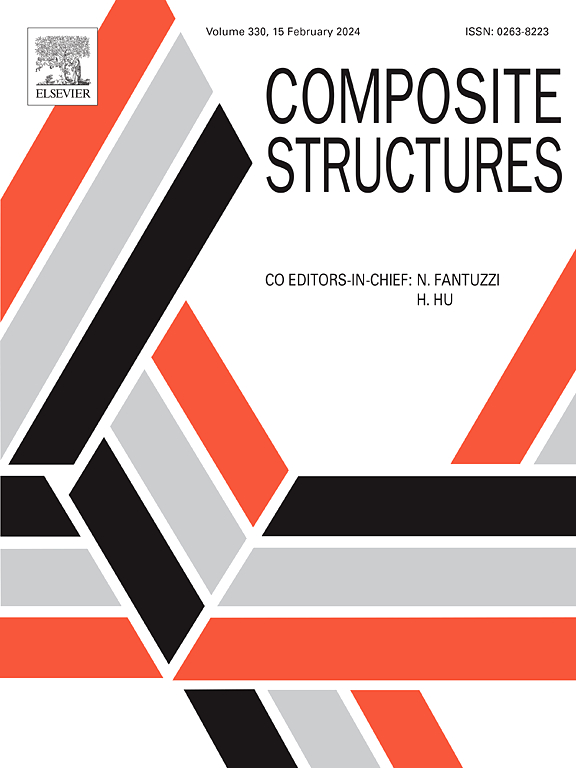基于改进的高阶 RAMP 插值模型的拓扑优化和曲面方形蜂窝夹层结构的弯曲特性研究
IF 6.3
2区 材料科学
Q1 MATERIALS SCIENCE, COMPOSITES
引用次数: 0
摘要
表面积较大的弧形蜂窝夹层结构可有效减少紧固件和连接器的数量,从而减轻重量、节约成本并提高可靠性。方形蜂窝具有更高的平面抗拉强度,与机械部件的兼容性更好。拓扑优化可以实现方形蜂窝的变密度设计,提高曲面夹层结构的强度和刚度,但收敛速度快的高阶材料特性合理逼近(RAMP)插值模型在拓扑边界的清晰度和稳定性相对较差。因此,针对曲面方形蜂窝夹层结构,开发了一种基于改进型高阶 RAMP 模型的变密度拓扑优化方法。通过在材料插值函数中加入最小模量项,并采用双向进化结构优化(BESO)来完善最优化标准(OC)方法,改进了高阶 RAMP 插值模型。利用密度映射法构建了十字形单元(即由四个相邻正方形单元组成的十字形简化模型)壁厚与拓扑单元相对密度之间的函数关系,并以十字形单元相对密度为设计变量进行拓扑优化,以最大限度地降低芯材的顺应性。对不同芯材保留率和面板厚度的三维打印非优化和优化弧形蜂窝夹层结构进行了三点弯曲试验,并将试验结果与模拟结果进行比较,以探索其弯曲性能和破坏行为。结果表明,改进的高阶 RAMP 插值模型提高了拓扑结构的清晰度和稳定性,变密度拓扑优化显著改善了曲面方形蜂窝夹层结构的弯曲性能,实验结果与数值结果基本一致。本文章由计算机程序翻译,如有差异,请以英文原文为准。
Topology optimization based on the improved high-order RAMP interpolation model and bending properties research for curved square honeycomb sandwich structures
Curved honeycomb sandwich structures with larger surface areas effectively reduce the number of fasteners and connectors, resulting in weight reduction, cost savings, and reliability improvement. Square honeycombs exhibit higher in-plane tensile strength, and are more compatible with mechanical components. Topology optimization can realize the variable-density design of square honeycombs, enhancing the strength and stiffness of curved sandwich structures, but the high-order Rational Approximation of Material Properties (RAMP) interpolation model with a fast convergence rate has the relatively poor clarity and stability in topology boundaries. Hence, a variable-density topology optimization method based on the improved high-order RAMP model is developed for curved square honeycomb sandwich structures. The high-order RAMP interpolation model is improved by incorporating a minimum modulus term into the material interpolation function and employing the Bi-directional Evolutionary Structural Optimization (BESO) to refine the Optimality Criteria (OC) method. A functional relationship between the wall thickness of cross-shaped cells (i.e., simplified models of four adjacent square cells arranged in a cross) and the relative density of topology units is constructed using a density mapping method, and the topology optimization with the relative density of cross-shaped cells as the design variable is performed to minimize the compliance of the core. Three-point bending tests are conducted on 3D printed non-optimized and optimized curved honeycomb sandwich structures with different core material retention rates and panel thicknesses, and the experimental results are compared with those of simulations to explore the bending properties and failure behaviors. The results indicate that the modified high-order RAMP interpolation model enhances the clarity and stability of topology structures, the variable-density topology optimization significantly improves the bending properties of curved square honeycomb sandwich structures, and the experimental and numerical results are largely consistent.
求助全文
通过发布文献求助,成功后即可免费获取论文全文。
去求助
来源期刊

Composite Structures
工程技术-材料科学:复合
CiteScore
12.00
自引率
12.70%
发文量
1246
审稿时长
78 days
期刊介绍:
The past few decades have seen outstanding advances in the use of composite materials in structural applications. There can be little doubt that, within engineering circles, composites have revolutionised traditional design concepts and made possible an unparalleled range of new and exciting possibilities as viable materials for construction. Composite Structures, an International Journal, disseminates knowledge between users, manufacturers, designers and researchers involved in structures or structural components manufactured using composite materials.
The journal publishes papers which contribute to knowledge in the use of composite materials in engineering structures. Papers deal with design, research and development studies, experimental investigations, theoretical analysis and fabrication techniques relevant to the application of composites in load-bearing components for assemblies, ranging from individual components such as plates and shells to complete composite structures.
 求助内容:
求助内容: 应助结果提醒方式:
应助结果提醒方式:


